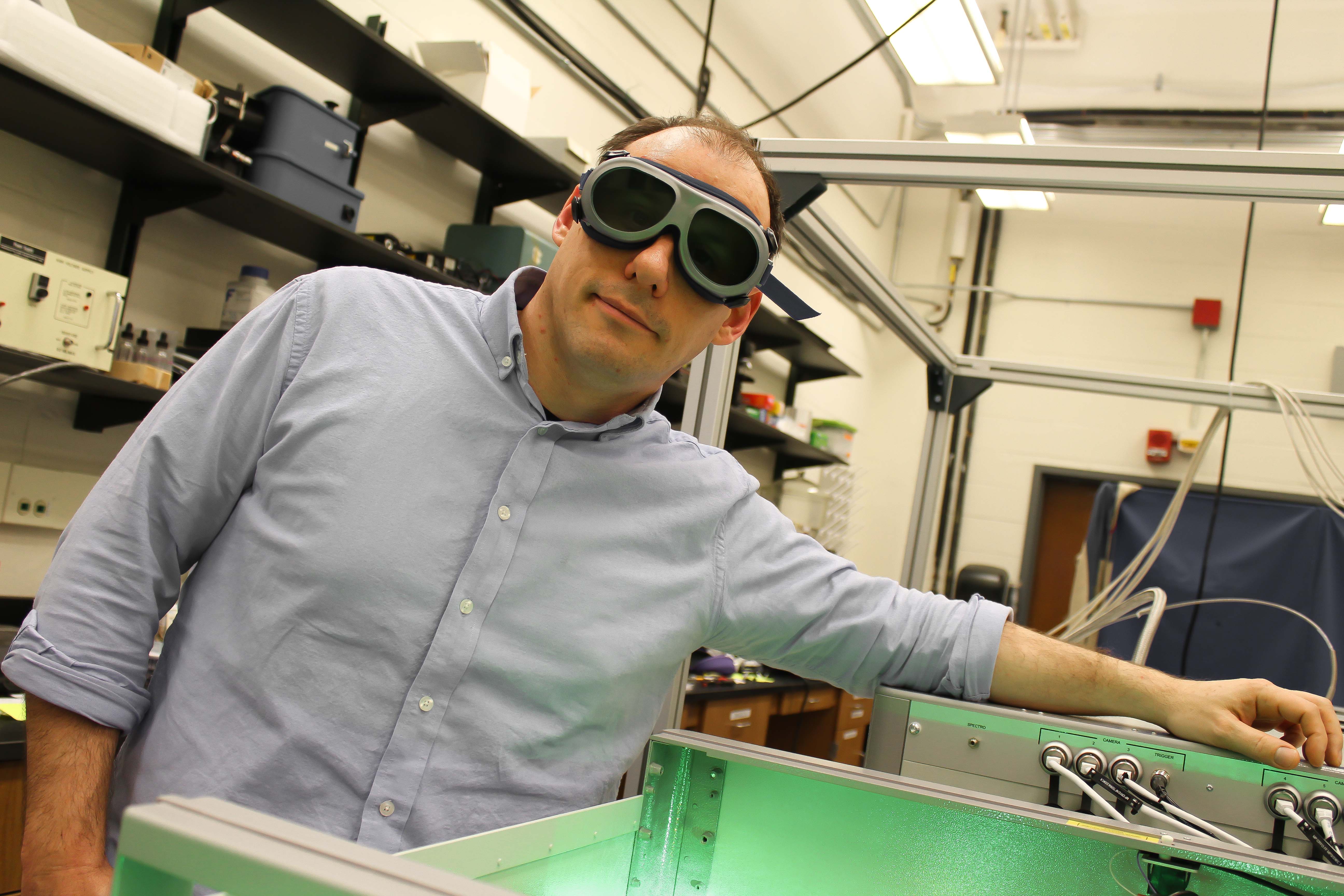From studying the mysterious fabric of our universe to advancing quantum computing to enabling communication over vast distances, ultrafast laser technologies drive advancements across many fields and applications. New research is taking lasers – and UConn – further.
UConn Department of Physics researchers – including lead author and Ph.D. student Kevin Watson, research faculty Tobias Saule, Professor Carlos Trallero, Professor and member of the National Academy of Science Nora Berrah, Professor and Department Head George Gibson, and their co-authors – have broken new ground by achieving higher peak power and average power in optical pulses than ever before with a novel class of lasers. Their findings are published in Optica.
Trallero says this research studies how lasers with high peak power and high average power interact with molecular gas. The high peak and average powers mean each laser pulse, though quick, is very intense.
“As a laser propagates, it interacts non-linearly with the molecules, and in doing so, it creates new frequency components,” he says.
Trallero explains these newly created components allow researchers to alter other qualities of the laser pulse, such as making the pulses shorter in duration.
“Before this paper was published, the established knowledge was that for very intense lasers, the repetition of the laser pulses could not be too high, because what happens is they would heat up the molecules too much, and in doing so, the laser would stop targeting the molecules in such a way that would allow it to add more frequencies,” says Trallero.
The world record for using nitrogen molecular gas to broaden these pulses was around 20 watts of average power. However, with this research, Trallero and his collaborators were able to break new ground and increase the pulses by more than a factor of ten to 250 watts.
“We prove that not only can we increase this, but that we are not limited by how many pulses in time we have, but that the limitation is really the structure of the molecule,” says Trallero. “As long as the pulses have a certain pulse duration, we can propagate these very intense pulses through any gas. The limitation is not the power of the laser but the relationship between the short pulses and the structure of the molecules we are propagating through, in particular, the role of the rotational and vibrational structure. This is kind of a big deal.”
This research could help advance the use of high-power lasers in applications ranging from defense to long-range communication, and the authors believe it will inform future directed energy research.
“All of these lasers carry what we call directed energy. For example, if you want to direct energy for communication, say from here to Mars, you have to go through Earth’s atmosphere, then Mars’s atmosphere,” says Trallero. “That’s a lot of molecular gases, and you don’t want those lasers to change too much. Knowing how these powerful lasers can propagate is relevant knowledge for a lot of things.”
This project has been in the making for many years, and the purchase of the state-of-the-art laser was made possible with money from a grant from the CLAS Research Equipment Funding Program and a collaboration between UConn, Few-cycle, Amphos, and the TRUMPF Group. Though progress was initially stalled by the pandemic and the challenges of working across three countries, the collaboration has been making great strides since. In January, Trallero and collaborators met with the TRUMPF Americas group, to demonstrate this new research and explore a formal joint research agreement with UConn. This collaboration links UConn researchers and students with TRUMPF, which is one of the largest lasers companies in the world.
“I think it shows that we can do great things with these world-class lasers, and here at UConn, we have people who are extremely well recognized in this field, which helps put UConn on the map for sure,” says Trallero.
The partnership solidifies UConn’s position as a world-class laser research institution and helps ensure UConn students are well-connected to industry opportunities both before and after they graduate. Trallero points out that there are many other UConn researchers who are prominent in the optics field, including Berrah and Dean of the College of Engineering Ji-Cheng ‘JC’ Zhao.
As a pioneer in the field, Trallero and his research group are busy putting the technology to the test for both applied and fundamental research. One project funded by the Department of Energy is at the most fundamental level, where the researchers are attempting to capture three-dimensional movies of electron motion in molecules in real-time.
Trallero’s group is also utilizing a technique called attosecond interferometry in which very short laser pulses can interfere with one another. This interference allows for very precise measurements between molecules in each wave taken at the attosecond time scale.
“The laser pulses are extremely short,” says Trallero. “I like to use the comparison used for the 2023 Nobel Prize in physics. If you think about a second, and you think about the entire life of the universe, of roughly 13 and a half billion years, there have been as many seconds in the entire history of the universe as there are attoseconds in one second. In my lab we have not just one attosecond pulse, we have two. We can interfere them, and that interference gives us access to the zeptosecond time scale which is 10 to the minus 21 seconds. With this new laser, we are hopeful that we can break the 10 to the minus 24 seconds, or yactoseconds.”
Trallero says it can be hard to wrap one’s mind around these incredibly tiny timeframes. However, this fundamental knowledge, coupled with strong ties to industry giants, has massive potential to push the boundaries of innovation.
Gibson is very enthusiastic about this research and says,
“When I first came to UConn in 1993, I designed and built the first high-repetition rate femtosecond laser in Connecticut, as they were not yet commercially available. It is very gratifying to see how UConn has continued to lead in this field with the arrival of Professor Berrah and then Professor. Trallero. They have each broken new ground in ultrafast physics and technology, making UConn an internationally recognized center for ultrafast science.”
This work was made possible with funding from the Air Force Office of Scientific Research (FA9550-21-1-0387); Office of Naval Research (N00014-18-1-2872, N00014-19-1-2339); Basic Energy Sciences (DE-SC0024508), US Department of Energy, Office of Science, Chemical Sciences, Geosciences, & Biosciences Division, the Directed Energy Professional Society, and the College of Liberal Arts and Sciences of the University of Connecticut.



